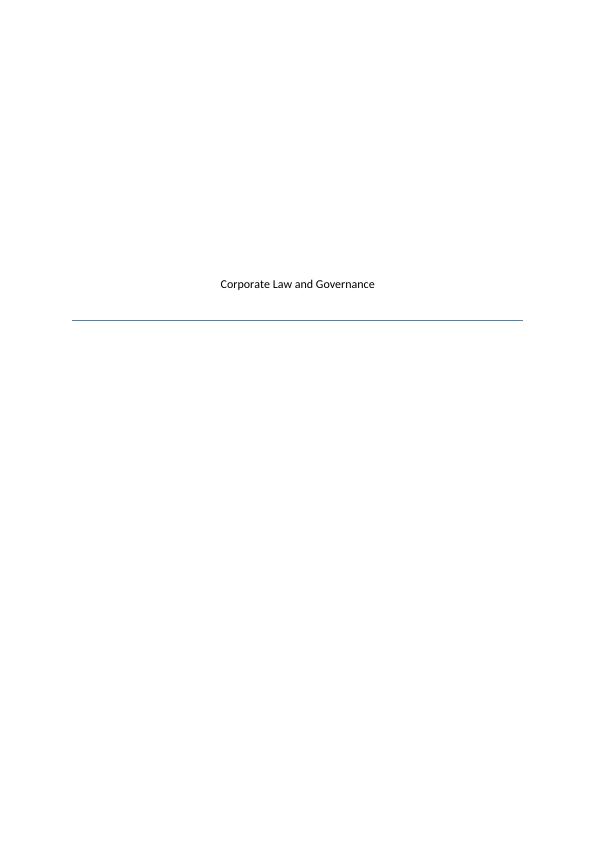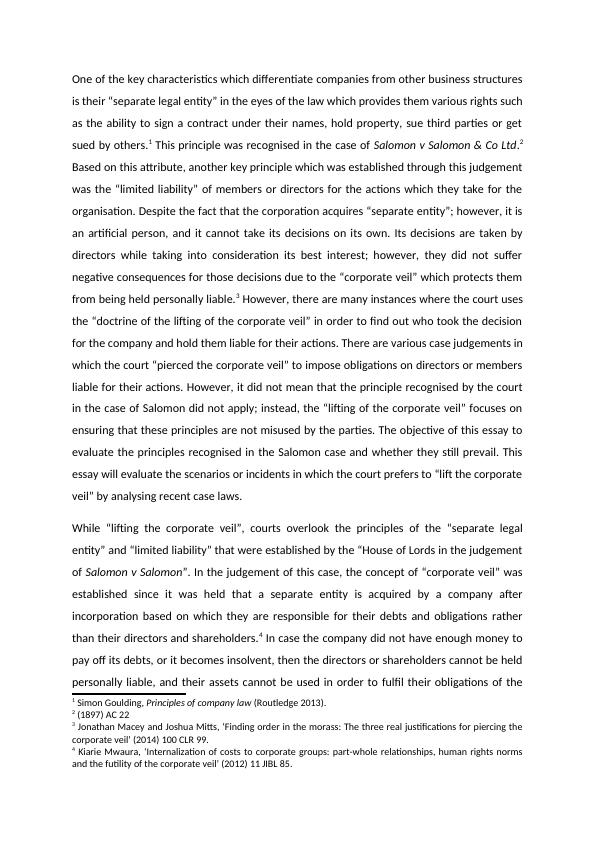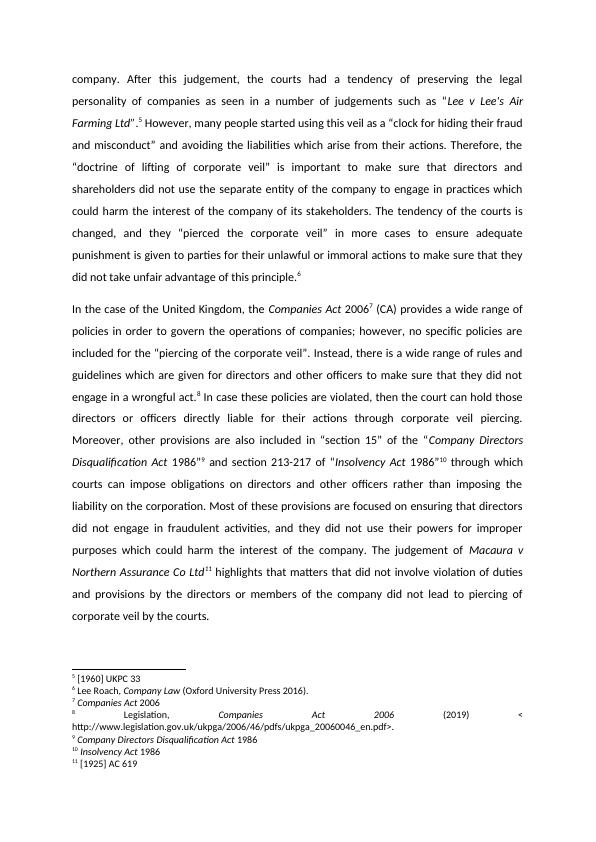Corporate Law and Governance
Record of submission and declaration form for a coursework assessment in the module Corporate Law and Governance.
12 Pages4245 Words94 Views
Added on 2023-03-17
About This Document
This essay evaluates the principles of corporate law and governance, focusing on the concept of separate legal entity and limited liability. It explores the doctrine of lifting the corporate veil and its application in recent case laws. The essay also discusses the circumstances in which the court overlooks the Salomon principle and imposes liabilities on directors and shareholders.
Corporate Law and Governance
Record of submission and declaration form for a coursework assessment in the module Corporate Law and Governance.
Added on 2023-03-17
ShareRelated Documents
Corporate Law and Governance

One of the key characteristics which differentiate companies from other business structures
is their “separate legal entity” in the eyes of the law which provides them various rights such
as the ability to sign a contract under their names, hold property, sue third parties or get
sued by others.1 This principle was recognised in the case of Salomon v Salomon & Co Ltd.2
Based on this attribute, another key principle which was established through this judgement
was the “limited liability” of members or directors for the actions which they take for the
organisation. Despite the fact that the corporation acquires “separate entity”; however, it is
an artificial person, and it cannot take its decisions on its own. Its decisions are taken by
directors while taking into consideration its best interest; however, they did not suffer
negative consequences for those decisions due to the “corporate veil” which protects them
from being held personally liable.3 However, there are many instances where the court uses
the “doctrine of the lifting of the corporate veil” in order to find out who took the decision
for the company and hold them liable for their actions. There are various case judgements in
which the court “pierced the corporate veil” to impose obligations on directors or members
liable for their actions. However, it did not mean that the principle recognised by the court
in the case of Salomon did not apply; instead, the “lifting of the corporate veil” focuses on
ensuring that these principles are not misused by the parties. The objective of this essay to
evaluate the principles recognised in the Salomon case and whether they still prevail. This
essay will evaluate the scenarios or incidents in which the court prefers to “lift the corporate
veil” by analysing recent case laws.
While “lifting the corporate veil”, courts overlook the principles of the “separate legal
entity” and “limited liability” that were established by the “House of Lords in the judgement
of Salomon v Salomon”. In the judgement of this case, the concept of “corporate veil” was
established since it was held that a separate entity is acquired by a company after
incorporation based on which they are responsible for their debts and obligations rather
than their directors and shareholders.4 In case the company did not have enough money to
pay off its debts, or it becomes insolvent, then the directors or shareholders cannot be held
personally liable, and their assets cannot be used in order to fulfil their obligations of the
1 Simon Goulding, Principles of company law (Routledge 2013).
2 (1897) AC 22
3 Jonathan Macey and Joshua Mitts, ‘Finding order in the morass: The three real justifications for piercing the
corporate veil’ (2014) 100 CLR 99.
4 Kiarie Mwaura, ‘Internalization of costs to corporate groups: part-whole relationships, human rights norms
and the futility of the corporate veil’ (2012) 11 JIBL 85.
is their “separate legal entity” in the eyes of the law which provides them various rights such
as the ability to sign a contract under their names, hold property, sue third parties or get
sued by others.1 This principle was recognised in the case of Salomon v Salomon & Co Ltd.2
Based on this attribute, another key principle which was established through this judgement
was the “limited liability” of members or directors for the actions which they take for the
organisation. Despite the fact that the corporation acquires “separate entity”; however, it is
an artificial person, and it cannot take its decisions on its own. Its decisions are taken by
directors while taking into consideration its best interest; however, they did not suffer
negative consequences for those decisions due to the “corporate veil” which protects them
from being held personally liable.3 However, there are many instances where the court uses
the “doctrine of the lifting of the corporate veil” in order to find out who took the decision
for the company and hold them liable for their actions. There are various case judgements in
which the court “pierced the corporate veil” to impose obligations on directors or members
liable for their actions. However, it did not mean that the principle recognised by the court
in the case of Salomon did not apply; instead, the “lifting of the corporate veil” focuses on
ensuring that these principles are not misused by the parties. The objective of this essay to
evaluate the principles recognised in the Salomon case and whether they still prevail. This
essay will evaluate the scenarios or incidents in which the court prefers to “lift the corporate
veil” by analysing recent case laws.
While “lifting the corporate veil”, courts overlook the principles of the “separate legal
entity” and “limited liability” that were established by the “House of Lords in the judgement
of Salomon v Salomon”. In the judgement of this case, the concept of “corporate veil” was
established since it was held that a separate entity is acquired by a company after
incorporation based on which they are responsible for their debts and obligations rather
than their directors and shareholders.4 In case the company did not have enough money to
pay off its debts, or it becomes insolvent, then the directors or shareholders cannot be held
personally liable, and their assets cannot be used in order to fulfil their obligations of the
1 Simon Goulding, Principles of company law (Routledge 2013).
2 (1897) AC 22
3 Jonathan Macey and Joshua Mitts, ‘Finding order in the morass: The three real justifications for piercing the
corporate veil’ (2014) 100 CLR 99.
4 Kiarie Mwaura, ‘Internalization of costs to corporate groups: part-whole relationships, human rights norms
and the futility of the corporate veil’ (2012) 11 JIBL 85.

company. After this judgement, the courts had a tendency of preserving the legal
personality of companies as seen in a number of judgements such as “Lee v Lee's Air
Farming Ltd”.5 However, many people started using this veil as a “clock for hiding their fraud
and misconduct” and avoiding the liabilities which arise from their actions. Therefore, the
“doctrine of lifting of corporate veil” is important to make sure that directors and
shareholders did not use the separate entity of the company to engage in practices which
could harm the interest of the company of its stakeholders. The tendency of the courts is
changed, and they “pierced the corporate veil” in more cases to ensure adequate
punishment is given to parties for their unlawful or immoral actions to make sure that they
did not take unfair advantage of this principle.6
In the case of the United Kingdom, the Companies Act 20067 (CA) provides a wide range of
policies in order to govern the operations of companies; however, no specific policies are
included for the “piercing of the corporate veil”. Instead, there is a wide range of rules and
guidelines which are given for directors and other officers to make sure that they did not
engage in a wrongful act.8 In case these policies are violated, then the court can hold those
directors or officers directly liable for their actions through corporate veil piercing.
Moreover, other provisions are also included in “section 15” of the “Company Directors
Disqualification Act 1986”9 and section 213-217 of “Insolvency Act 1986”10 through which
courts can impose obligations on directors and other officers rather than imposing the
liability on the corporation. Most of these provisions are focused on ensuring that directors
did not engage in fraudulent activities, and they did not use their powers for improper
purposes which could harm the interest of the company. The judgement of Macaura v
Northern Assurance Co Ltd11 highlights that matters that did not involve violation of duties
and provisions by the directors or members of the company did not lead to piercing of
corporate veil by the courts.
5 [1960] UKPC 33
6 Lee Roach, Company Law (Oxford University Press 2016).
7 Companies Act 2006
8 Legislation, Companies Act 2006 (2019) <
http://www.legislation.gov.uk/ukpga/2006/46/pdfs/ukpga_20060046_en.pdf>.
9 Company Directors Disqualification Act 1986
10 Insolvency Act 1986
11 [1925] AC 619
personality of companies as seen in a number of judgements such as “Lee v Lee's Air
Farming Ltd”.5 However, many people started using this veil as a “clock for hiding their fraud
and misconduct” and avoiding the liabilities which arise from their actions. Therefore, the
“doctrine of lifting of corporate veil” is important to make sure that directors and
shareholders did not use the separate entity of the company to engage in practices which
could harm the interest of the company of its stakeholders. The tendency of the courts is
changed, and they “pierced the corporate veil” in more cases to ensure adequate
punishment is given to parties for their unlawful or immoral actions to make sure that they
did not take unfair advantage of this principle.6
In the case of the United Kingdom, the Companies Act 20067 (CA) provides a wide range of
policies in order to govern the operations of companies; however, no specific policies are
included for the “piercing of the corporate veil”. Instead, there is a wide range of rules and
guidelines which are given for directors and other officers to make sure that they did not
engage in a wrongful act.8 In case these policies are violated, then the court can hold those
directors or officers directly liable for their actions through corporate veil piercing.
Moreover, other provisions are also included in “section 15” of the “Company Directors
Disqualification Act 1986”9 and section 213-217 of “Insolvency Act 1986”10 through which
courts can impose obligations on directors and other officers rather than imposing the
liability on the corporation. Most of these provisions are focused on ensuring that directors
did not engage in fraudulent activities, and they did not use their powers for improper
purposes which could harm the interest of the company. The judgement of Macaura v
Northern Assurance Co Ltd11 highlights that matters that did not involve violation of duties
and provisions by the directors or members of the company did not lead to piercing of
corporate veil by the courts.
5 [1960] UKPC 33
6 Lee Roach, Company Law (Oxford University Press 2016).
7 Companies Act 2006
8 Legislation, Companies Act 2006 (2019) <
http://www.legislation.gov.uk/ukpga/2006/46/pdfs/ukpga_20060046_en.pdf>.
9 Company Directors Disqualification Act 1986
10 Insolvency Act 1986
11 [1925] AC 619

There is still ambiguity regarding the circumstances where courts overlook the Salomon
principle; however, previous judgements have highlighted certain scenarios where
“separate entity” of organisations are likely to be avoided by courts. One of the key
elements is “fraud or improper conduct” by the directors or other officers lead to “piercing
of corporate veil”.12 The court did not allow parties to use the Salomon principle to protect
themselves from facing the liabilities which arise because they engage in fraudulent
practices and misconduct. In this regards, relevant judgements were provided in the court in
two leading cases, including “Gilford Motor Co Ltd v Horne”13 and “Jones v Lipman”.14 In the
first case, an agreement was formed between the “Gilford Motor Company” and an
employee through the employment contract to make sure that the employee did not solicit
the customers after the left the organisation. Horne was the managing director who was
fired, and he decided to launch an organisation for competing with Gilford. In the
organisation, there were no other shareholders and the responsibility for managing the
operations were also imposed on Horne.15
Gilford sued the company, and the court “lifted the corporate veil” in the judgement. It was
identified that Horne wanted to conduct “sham and fraud” and he wanted to avoid
compliance with legal restrictions based on which this principle can be applied. In this
regards, “Jones v Lipman” is an important case in which an agreement was formed for
selling of a house; however, Lipman backed on his promise and he avoided the compliance
with contractual obligations by transferring ownership of the land to a corporation in which
he was the sole director and shareholder.16 In its judgement, the court provided that the
company is established for the purpose of transferring the house and Lipman is using it as a
device of sham based on which the corporate veil can be pierced, and Lipman was held
liable. In the case of “Woolfson v Strathclyde Regional Council”17, the court provided that the
“veil can only be lifted in special circumstances” which include if the company is a “mere
façade” that is formed in order to conceal the true facts to gain an unfair advantage or
cause harm to another person.
12 Lorraine Talbot, Critical company law (Routledge 2015).
13 [1933] Ch 935
14 [1962] 1 WLR 832
15 Pey Woan Lee, ‘The enigma of veil-piercing’ (2015) 26 (1) ICCLR 28.
16 Alexander Schall, ‘The new law of piercing the corporate veil in the UK’ (2016) 13 (4) ECFLR 549-574.
17 [1978] UKHL 5
principle; however, previous judgements have highlighted certain scenarios where
“separate entity” of organisations are likely to be avoided by courts. One of the key
elements is “fraud or improper conduct” by the directors or other officers lead to “piercing
of corporate veil”.12 The court did not allow parties to use the Salomon principle to protect
themselves from facing the liabilities which arise because they engage in fraudulent
practices and misconduct. In this regards, relevant judgements were provided in the court in
two leading cases, including “Gilford Motor Co Ltd v Horne”13 and “Jones v Lipman”.14 In the
first case, an agreement was formed between the “Gilford Motor Company” and an
employee through the employment contract to make sure that the employee did not solicit
the customers after the left the organisation. Horne was the managing director who was
fired, and he decided to launch an organisation for competing with Gilford. In the
organisation, there were no other shareholders and the responsibility for managing the
operations were also imposed on Horne.15
Gilford sued the company, and the court “lifted the corporate veil” in the judgement. It was
identified that Horne wanted to conduct “sham and fraud” and he wanted to avoid
compliance with legal restrictions based on which this principle can be applied. In this
regards, “Jones v Lipman” is an important case in which an agreement was formed for
selling of a house; however, Lipman backed on his promise and he avoided the compliance
with contractual obligations by transferring ownership of the land to a corporation in which
he was the sole director and shareholder.16 In its judgement, the court provided that the
company is established for the purpose of transferring the house and Lipman is using it as a
device of sham based on which the corporate veil can be pierced, and Lipman was held
liable. In the case of “Woolfson v Strathclyde Regional Council”17, the court provided that the
“veil can only be lifted in special circumstances” which include if the company is a “mere
façade” that is formed in order to conceal the true facts to gain an unfair advantage or
cause harm to another person.
12 Lorraine Talbot, Critical company law (Routledge 2015).
13 [1933] Ch 935
14 [1962] 1 WLR 832
15 Pey Woan Lee, ‘The enigma of veil-piercing’ (2015) 26 (1) ICCLR 28.
16 Alexander Schall, ‘The new law of piercing the corporate veil in the UK’ (2016) 13 (4) ECFLR 549-574.
17 [1978] UKHL 5

End of preview
Want to access all the pages? Upload your documents or become a member.
Related Documents
Corporate Law Assignmentlg...
|6
|1576
|190
Lifting the Corporate Veil: Circumstances and Implicationslg...
|7
|1918
|31
Liability of Partners in Partnership Lawlg...
|8
|2081
|52
Piercing of Corporate Veil in Australian Contextlg...
|13
|3525
|318
Company Law: Salomon v Salomon & Co Ltd, Vicarious Liability, Contract Law, and Director's Legal Obligationslg...
|9
|2281
|376
Liabilities of Anne and Mary for Actions Taken by Jane and Sarahlg...
|8
|2316
|61
